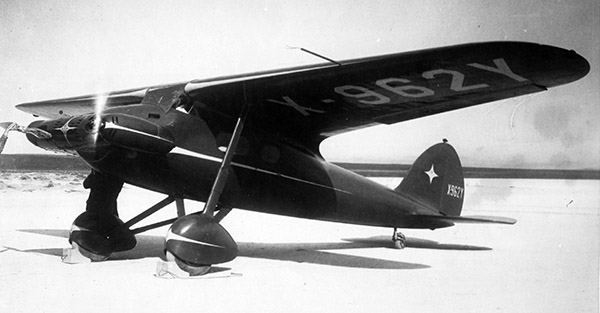The Loughead Brothers Aircraft Corporation existed from 1930 to 1934. Located in Glendale, California, the Loughead Duo-Six (X962Y) proved to be the only aircraft they constructed. It should be noted that the airplane possessed another name – the Olympic Duo-Six. This seemed to capitalize on the 1932 Olympics held in Los Angeles.
Loughead Duo-Six Flight Test
The Duo-Six retained the basic configuration of the Loughead Vega. Built as a demonstrator for a novel powerplant installation, test flights took place on Rosamond Dry Lake. Loughead used 130-hp Menasco B-6 Buccaneer engines. He placed two of the inline engines on each side of the aircraft’s nose. A minimum space existed to clear the propeller arcs. In this way, Loughead hoped to minimize directional control problems in the event of an engine failure. Limited tests proved encouraging. Even so, an unexpected high wind caused the Duo-Six to crash into an automobile. This accident, coupled with the company’s insufficient capitalization, ended the Duo-Six.
Allan Loughead
In 1934, Allan Loughead legally changed his last name to Lockheed. After all, it was the phonetic spelling of his family name. He hoped this might avoid any spelling confusion. Three years later, he formed the Alco Aircraft Corporation in Oakland, California. The Alcor C.6.1 Junior Transport proved to be the company’s aircraft. Described as a six-passenger, low wing design, it included a retractable main undercarriage. The Junior, (NX15544), retained the powerplant configuration of the Duo-6. He replaced the 130-hp Buccaneers with 260-hp Menasco C6S-4 six-cylinder inline air-cooled engines. Sadly, a high-speed dive test flight on June 27, 1938, destroyed the Junior. The Alco Corporation met the same fate as did the Loughead Brothers Aircraft Corporation.
The Lockheed Corporation
Despite the loss of the Duo-Six and the Alcor Junior, Allan Lockheed found great success with his engineering designs. He laid the foundation for a forward-looking aircraft company – the Lockheed Corporation.

